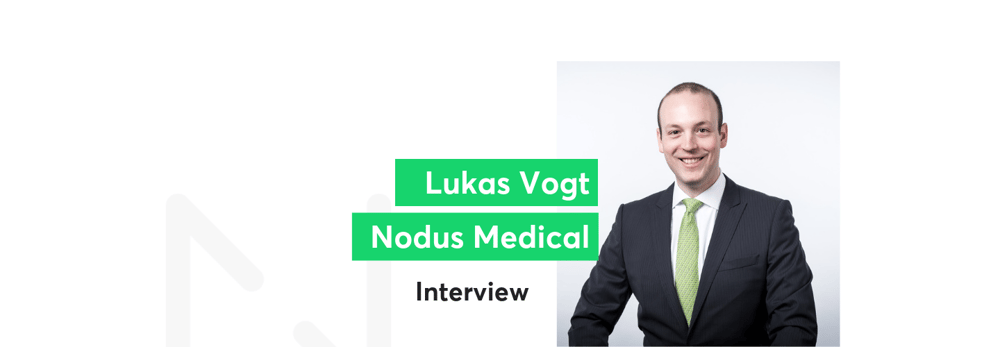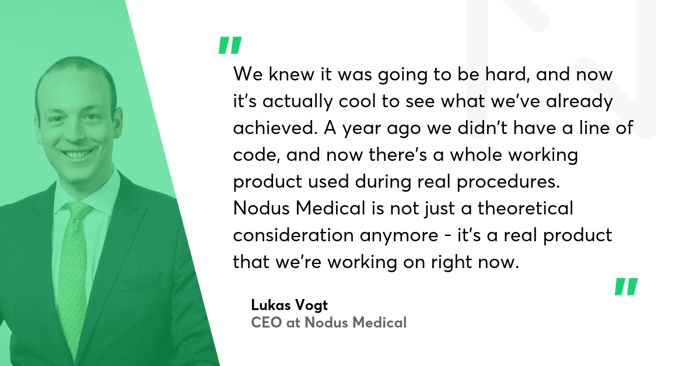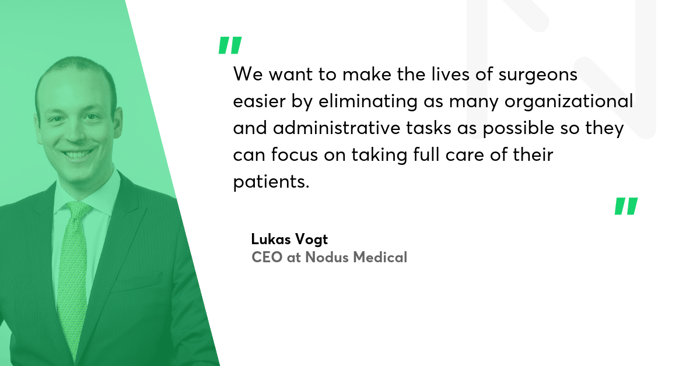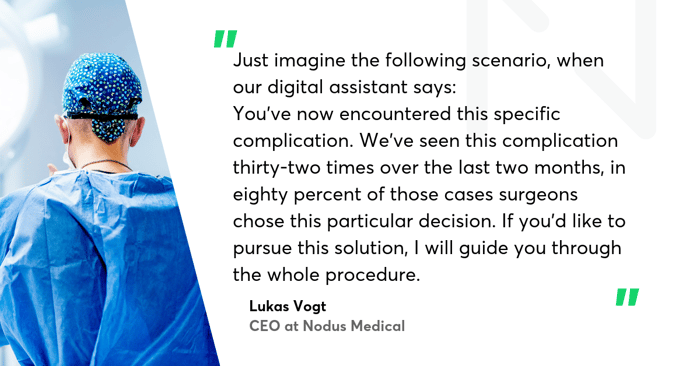“If You Can Save a Thousand Lives a Day, Everything Else Doesn’t Really Matter” - Interview with Lukas Vogt, former CEO at Nodus Medical

In the area of up to 40%* avoidable post-operational complications, the top-level military aviation standards developed and improved over the years can be in huge demand.
Nodus Medical, a healthcare startup from Switzerland, has found a way to combine these two worlds. Their digital assistant aims to introduce the best standards of military aviation into the European operating theaters. We’ve interviewed Lukas Vogt, former CEO at Nodus Medical, to see how the idea was born and what are their plans for the future.
Rafal Salak: Nodus Medical built a digital assistant that’s meant to improve the safety of surgical procedures with military aviation standards - how did you come up with this idea?
Lukas Vogt: It’s mostly thanks to Marc Studer, who’s the chairman of Nodus Medical and one of our founders. Marc is one of the people who luckily made their childhood dreams come true - he became a Swiss fighter jet pilot with over 10 years of experience. But then he actually decided there’s something missing in his life, and that’s how his medical career began. Marc did six years of medical school training. It included a lot of practical aspects, like attending surgeries in the operating theater to support more senior surgeons. That’s where he started realizing that aviation and surgery have a lot in common. But what he also noticed was that there were things that work really well in aviation, but were yet unknown in the operating room.
Can you give some examples?
Let’s say you’re a fighter jet pilot. Even if you have over three thousand hours of flying experience, you would never approach your landing zone without going through the checks and procedures that have been defined for this specific airport and this specific aircraft. It’s actually perfectly common for many surgeons to go into an operating room, go through the procedure in a completely random order, and suddenly find themselves in the middle of an operation wondering if they should actually operate on the patient’s left or right leg.
And this is the entire idea that stands behind Nodus Medical: to draw inspiration from the way that aviation - military aviation in particular - has improved its efficiency and the safety track record over the past decades and bring these solutions into the operating room.

So how do you define your goals?
I would say we are pursuing two goals. On one hand, we want to make the lives of surgeons easier by eliminating as many organizational and administrative tasks as possible so they can focus on taking full care of their patients.
On the other hand, we want to help surgical teams actually make their own procedures much safer in order to decrease post-operational complications. Surgical procedures can be seen as a mass market: each day, there are thousands of procedures all over the world which, in many cases, end well for patients. And such a great success rate already means a huge improvement in terms of the quality of our life. But there’s also a lot of cases where something goes wrong and a patient dies even though this could have been avoided just by following certain checks or precautions. Which is why I always say that our basic and major goal is to help surgical teams all around the world avoid a thousand deaths every day.
Are there any other metrics that you aim to have an impact on?
There's obviously a broad range of metrics that are important to us and our business. For instance, we want to constantly increase the satisfaction of entire surgical teams: not only the lead surgeon, but also resident surgeons who are often frustrated, overworked, and thus don’t get enough sleep. These people often don't feel respected, don't feel they get the coaching that they need - and that’s crucial for them as future surgeons. It’s also about other medical specialists, like operating nurses who - and that’s something we’ve heard quite a lot of - often feel like it’s forbidden for them to speak up and point out some procedural errors, even if they might lead to post-operational complications. From a commercial perspective, avoiding procedural complications is usually much cheaper for a hospital.
There's also the context of inventory management. Many hospitals store insane amounts of instruments, implants and various equipment anywhere they can fit them in because they want to have them available just in case. And if they just followed relatively basic planning steps and practiced structured workflow management, they could dramatically decrease these numbers. If you compare it to other industries, car manufacturing, for example, you’ll notice there’s a huge gap between them due to the lean transformation most industries have undergone in the past couple of years.
As a company, we also look at how our product is being used and what are the results. Like every business, we’re primarily focused on new customer acquisition. Also, since we operate in healthcare, where tolerance for critical issues is relatively low, we’re constantly improving the quality of our software. But the truth is that if you can get to save these thousand lives every day, everything else does not matter that much.
You had a soft launch of your assistant in November 2018. What was the initial feedback that you received?
We were satisfied with what we’ve heard. It's interesting to see that different aspects of our value proposition resonate differently with different target groups. For example, there are essentially two types of surgeons in Switzerland. There are self-employed surgeons who work in one particular hospital, and they have a fairly wide range of tasks. Typically they have to coach resident surgeons, run clinical research, and they also care about the entire operation and its flow. This group can get a huge gain from our value proposition.

Then you have independent surgeons, who are the second type of a potential customer. Essentially, they rent operating rooms from hospitals, hire operating teams, and find their own patients. As we’ve learned recently, in its current shape our product doesn’t bring too much value to this group - and it’s something we may address in the future.
There’s also what I think we already knew: what we’re facing is an enterprise software market. It’s not like we could launch our product in November and have 2 million users by January. The best case scenario is that it will take us at least nine months to get to this stage.
My favorite piece of feedback was received during one of our demos. There’s a common belief that modern hospitals still operate on legacy systems developed 10 or 15 years ago. What we were told was that our product didn’t look like a typical hospital software, and it was a positive thing. The user interface, all the workflows, dropdown menus, the navigation process in general - we’ve designed it all following a much more user-centric approach, often inspired by some of the best consumer software out there.
Obviously, there are also some negative examples. Early on, we’ve looked into how users actually use our software, trying to validate three different approaches that included a foot pedal, touch, and voice commands. We spoke to a group of surgeons and the feedback was very clear: touch is fine, voice commands are the best, drop the foot pedal. So we did and rolled it out without the pedal. After having the first procedures in January this year, we got very different feedback, basically telling us to bring the pedal back.
So now we're waiting for the first official launch?
Exactly. The product is going through a few pilot programs. There’s already a number of procedures that have been done with the assistance of our product. We also have an official pilot confirmed with one hospital in Switzerland that’s about to start at the beginning of May, and it’s a typical enterprise process involving matters like: can we get the sign-off from the data protection officer; are there any specific internal IT requirements we need to take into account; how do we schedule onboarding for all the users etc.
How about the senior hospital staff? Are they eager to use products like yours, or do expect that it will be hard to convince them?
We're experiencing a typical adoption wave. There’s a 2.5 percent group of innovators, then we see early adopters, and an early majority - they all are fairly receptive to what we're doing. But there's also a sizable number of surgeons who believe in the way they’ve been doing their job for many years and who don’t see a reason to change it now. And it’s not the senior staff only - there are also younger surgeons who have been doing work reasonably successfully and don’t feel the sense of urgency to change things. Convincing them to our story can be quite tricky.
We still need to do this, but fortunately for us, it’s not the majority of our potential customers. I think the medical industry has already understood the need for digital transformation. It doesn't mean we don't run into typical issues, like the “no cloud policy” in some hospitals, which makes it extremely hard for SaaS businesses like ours to work in such an environment.

I believe these are just temporary issues, but they give us the power to persevere nonetheless. And in the following years, as the senior staff will go to retirement, the younger generation of digital natives will step in with bigger roles and responsibilities, but probably they’ll also have a slightly better understanding of what it is that we're trying to achieve.
Since you’ve already mentioned it, what are the other challenges that you see ahead? And what kind of roadblocks have you had to overcome already?
I would say that the biggest question that we have ahead of us right now is how to help customers understand our value proposition in the quickest possible way. It's something you always have to work on and improve. How do we really tell our sales story? How do you find the right angle? In the beginning, we put a strong focus on how military aviation can improve surgery. But then, it appears to be more effective if we tell it more from a user journey perspective, as it makes it more approachable to an average surgeon. So that’s one of the things we’ve had to change quite a bit in our stories.
There's also the technology aspect. For instance, we’re at the point where we should decide if we should separate our databases from users’, to which we would have no access. Issues like this are not in our perfect agile environment scenario, but our customers require us to address them. Another challenge, as well as opportunity, is that mid-term we’ll probably also want our product to become “software as a medical device”, which means we will have to face fairly strict regulations and processes - it will require a lot of time and effort, but we believe it’s worth it.
We knew it was going to be hard, and now it's actually cool to see what we’ve already achieved. A year ago we didn't have a line of code, and now there’s a whole working product used during real procedures. Nodus Medical is not just a theoretical consideration anymore - it's a real product that we’re working on right now.
And how much does it actually cost a hospital to start using your assistant?
We work in a typical SaaS model. There’s a differentiated monthly offer, calculated on typical factors, like user count, their seniority, their role, etc. There’s no implementation fee whatsoever.
As an example, let's pick an individual Swiss orthopedic surgery clinic. Typically, it should have 10 to 20 surgeons, most probably around two-thirds of them would be senior surgeons and the rest are resident surgeons. We would probably be looking at an annual subscription fee between 30 and 50 thousand Euro. It makes an attractive business case on our side and, compared to what such a clinic usually pays for other medical devices, it's actually quite cheap. So far, we have not seen a case where the price would be an issue. Actually, we could presumably charge more for our software, but we don't want this to become an obstacle to our growth.
What about the competition. Who are your competitors?
Our competitors are basically all the relatively young companies trying to pursue something different or something similar but from a different angle. Our two main competitors are in the US, but so far they’re not building any presence in Europe at all. I would say there are also two or three companies here in Europe that are pursuing the same goals as we do.
The only one that we've actually encountered live in Switzerland is a company called Surgical Process Institute. They were acquired just over a year ago by Johnson & Johnson and they actually focus on hardware solutions, looking at a much higher price. For us, it's good to see others out there because it's always a confirmation that we’re not completely crazy and that there’s a need for ideas like ours. It's also good to have more people and companies talking about the industry, its problems, and how to solve them.
We believe we have certain factors that differentiate us from other competitors. Our team is one of them: the involvement of both surgeons and pilots ranks quite highly. But it’s also what I call the completeness of vision: we don’t focus on one aspect of our idea. We aim to help hospitals reduce administrative efforts. We support staff education. Content-wise, we help surgeons standardize their processes by building community features and letting them share their best practices and any relevant content with others. That’s how it works - but we know our competitors have done a great work here as well.
And with an English version available, do you plan to enter the US market?
Our current business plan does not include entering the U.S. market, so we don't need it to become a profitable metric, but it’s an attractive option we’d love to consider in the future. From our perspective, Europe is about two and a half times bigger in terms of the number of our potential users. It's not because there are fewer surgical procedures in the U.S., but it's because they're way more efficient in the way they run them. And we see this in real life as well. In the US it's fairly common for knee surgeons to do 13 or 14 knee surgeries in a day. Surgeons in Switzerland have one or two surgeries per day on average, and up to eight if you're in a more specialized hospital.
There’s a lot of differences between the U.S. and Europe in the way healthcare works. It’s a completely separate regulatory environment, it also differs in terms of how healthcare is paid for and consumed.
Let’s talk about your plans a little bit more. As a CEO, where do you see Nodus Medical three years from now?
I always look at it from two different levels. The first one first is the product perspective: we're building a very cool SaaS solution, a digital assistant that makes a surgeon’s life a lot easier.
And then there's the second level, as important as the first one: for the first time in history, we’re creating a structured database on how surgical procedures are conducted around the world. We believe that’s just the beginning of building a truly intelligent assistant that supports the surgeon in decision-making, both during the planning stage and in the OR. Just imagine the following scenario, when our assistant says:
You've now encountered this specific complication. We've seen this complication thirty-two times over the last two months, in eighty percent of those cases surgeons chose this particular decision. If you’d like to pursue this solution, I will guide you through the whole procedure.
And it’s important to mention that, in most cases, the way you’re treated today as a patient is based on the individual experience of the surgeon. An experienced surgeon may have up to twelve thousand procedures over the course of their career. It may sound impressive, but if you take into account some specific complications that occur once per every thousand cases, it’s a fairly small sample. So, once you start leveraging the combined know-how and experience of those 2 million potential users and specialists around the world, you start looking at a much bigger data set. It can deliver great value to all stakeholders, improving healthcare, leading to robotic-assisted surgeries and to more minimally invasive treatments. In two or three years’ time, we hope to be at the forefront of surgical intelligence.
What about the role of Netguru - how did the team support the whole project?
When we were starting out, we needed to be as quick as possible in terms of building and validating our product. We were looking for a true partner that could help us build the product, but would also bring the skill set needed for a successful launch and the post-launch maintenance period. We wanted to be agile and flexible in terms of current requirements and competencies, which is why we avoided relying on internal resources.
What convinced us is Netguru’s success story - it’s an interesting startup that has undergone a tremendous growth journey over the last couple of years.
Netguru has a great team that can really deliver on what's needed and I think we enjoy working together. We actually have a joint team of both Netguru engineers and ours instead of two separate teams that wouldn’t trust each other or couldn’t cooperate in an efficient and effective manner. And I feel that if there are any issues or roadblocks, we can always discuss them and find a reasonable solution that everyone’s happy with.
*Zegers M, de Bruijne MC, de Keizer B, et al. The incidence, root-causes, and outcomes of adverse events in surgical units: implication for potential prevention strategies. Patient Saf Surg. 2011;5:13. doi:10.1186/1754-9493-5-13.




-%20copy.jpeg?width=415&height=415)
